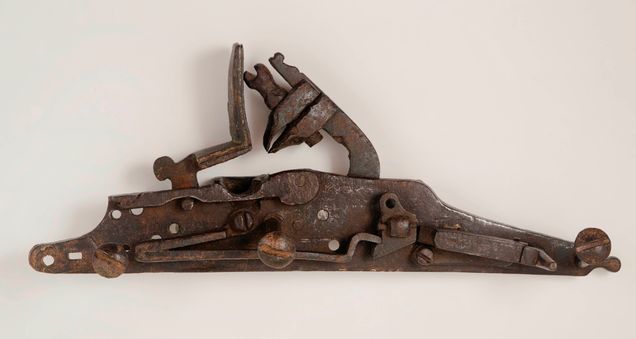Flintlock from musket [lock of the gun by which King Philip was killed, 1676]

Marin Bluestein, Alison Goldblatt, and Tyler Miller
This research paper analyzes the flintlock used to kill Metacom at the end of King Phillip’s war in 1676. Our essay first goes into detail about the mechanical specifics of the flintlock, in combination with other parts of the weapon. The flintlock is described as the most significant piece to the firing of any type of pistol, rifle, or musket. The procedure required for loading the weapon, which involved cleaning the barrel, adding more gunpowder, resetting the hammer and trigger, and inserting another bullet, is broken down to understand the long time taken between firing. The process that the flintlock uses to fire the bullet is depicted, involving the trigger pull releasing the hammer, the flint making contact with the frizzen, the sparks from the contact being released into the gunpowder chamber, and the ensuing explosion propelling the bullet. The involvement of the flintlock with the other parts of the weapon, like the barrel or bayonet, is established to understand how it fits in with the general use of the weapon. The materials used to create the weapon are traced back to their origin and followed through the process of sale, assembly, and use. The design is placed in context with previous and future mechanisms to understand where the idea for the flintlock came from and how it was improved upon. Finally, the aesthetic design and decoration of the weapon are detailed. This section draws upon books with accounts of the properties of the guns and their design from historical experts in order to come to sound conclusions about the flintlock.
In order to discuss the historical significance of the flintlock musket that killed King Philip, one must delve into who King Philip is, the general information regarding the cause of the wart, and why his death – done by the flintlock – was important. In this section, we discuss the relations that Massasoit had with the English settlers and how that differed from his son, King Philip’s relationship with the settlers. Then, King Philip’s War is briefly described. We note how some Native Americans were fighting on the side of the English, and from there we introduce John Alderman and analyze the situation in which he followed Benjamin Church and how this ultimately led to the demise of King Philip, using this specific flintlock. It is important that we emphasize the flintlock’s impact in this very moment, as well as what his death meant in their society. Additionally, we touch on the aftermath of the war, and what it meant for the English settlers and the Wampanoag people. We touch on how their lives changed after this moment in history, and why some aspects of life will never be the same thereon. Using research from the Massachusetts Historical Society’s website, New England Historical Society, the Connecticut History Organization website, the Society of Colonial Wars, and many more, we were able to piece together the events surrounding the flintlock musket, and what made it so crucial.
The development of weapons during the latter part of the 1600s is an essential part of understanding the significance of this specific flintlock musket. Lasting one year, King Philip’s War is the bloodiest war, per capita, in the history of the United States, which further emphasizes the importance of understanding the weapons available to both the Native Americans and the Colonists during the war. Both sides utilized different types of muskets. The colonists utilized matchlock muskets which were older and heavier than the newer flintlock muskets that the Native American troops used. The English settlers preferred them because they were more familiar with the way they worked and they felt more comfortable using them. Even with the most skilled shooter, the matchlock musket could only release one shot per minute. Additionally, the matchlock was extremely heavy, weighing in at around sixteen pounds. It’s the mechanism that required immense caution because the lit match cord was so close to the gunpowder within the musket. Overall, this weapon was relatively inferior to the flintlock musket that the Native Americans used. King Philip’s War is the first war it was used in. It was created in France during the early 1600s and became popular due to its increased reliability, safety, and simplicity. The flintlock was introduced to America around 1660, and it soon became the most popular weapon of that time. The flintlock could fire twice as fast as the matchlock, giving the Native Americans some advantage. In addition to muskets, Rapiers and Tomahawks were also utilized on both sides of the battlefield.